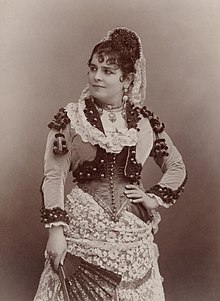Celestine Galli-Marié
Célestine Galli-Marié , née Marie-Célestine Laurence Marié de l'Isle (born November 1840 in Paris , † September 22, 1905 in Vence ) was a French opera singer ( mezzo-soprano ), the first Carmen in the opera of Georges Bizet .
Célestine Galli-Marié was the daughter of the opera singer (tenor, later baritone) Félix Mécène Marié de l'Isle (1811–1882), the first Tonio in Donizetti's regimental daughter , from whom she also received her first singing lessons. Her operatic debut was in Strasbourg in 1859 . In the same year she married the sculptor Galli and then called herself Galli-Marié on the stage. She had a child with him, but he died in 1861. She performed in Vichy, Toulouse and in Lisbon in 1861, and in the following years in opera houses in Belgium, France and Italy. After the director of the Paris Opéra comique heard her in Rouen (in The Bohemian Girl by Michael William Balfe ) he invited her to his opera in Paris, where she first appeared in 1862 as Servina in La serva padrona by Giovanni Battista Pergolesi , with a great deal Success. She rose to become the prima donna of the comic opera in Paris. On November 17, 1866, she sang the title role of Mignon in the opera Opera by Ambroise Thomas (1866), which became one of her star roles (alongside Carmen). In 1872 she sang in the world premiere of the opera Le Passant (by Émile Paladilhe , who was also her lover at times), which was remembered for the then popular aria La Manolinata . She was also successful with the aria Sorrentino in the opera Piccolino by Ernest Guiraud , which he wrote for her. She performed all over Europe
She sang Carmen in the world premiere on March 3, 1875 at the Opéra comique. The world premiere was not a success, later it was all the more successful and she sang Carmen all over Europe. The hundredth performance of Carmen in the comic opera took place in 1885. In the same year she ended her career at the comic opera, but in 1890 she appeared there again as Carmen in a charity performance for the erection of a monument to Bizet (with Nellie Melba , Jean de Reszke , Jean Lassalle ). She sang Carmen in Brussels in 1876, Monte Carlo (1879), Naples (1879, Italian premiere), Genoa, Barcelona (1881), Madrid (1882), Rome (1884), Milan (1883), Lyon, Liège, and Dieppe sang in London in 1886.
She was known for her large volume and good timbre, clear diction and phrasing. A high mezzo-soprano was sometimes referred to as a galli-marié . She was also known for her theatrical skills, according to Modest Ilyich Tchaikovsky , she combined unbridled passion with a fatalism that could be called mystical . She was slender and graceful, lively and very agile, so that one reviewer compared her to a cat. Her interpretation of Carmen on stage was very realistic, according to the critic Daniel Bernard , she photographed the gestures, expressions and clothing of the senoritas of the street.
Her student and niece Jean Marié de l'Isle (1872–1926) was also a singer, of which recordings exist that also allow conclusions to be drawn about the style and interpretation of her aunt. Her sisters Paola (1851–1920) and Irma Marié were also successful opera singers. The sister Mécéna was a cabaret singer.
Galli-Marié sang in several other world premieres ( Le Capitaine Henriot by François-Auguste Gevaert in 1864 as Blandine, Don César de Bazan by Jules Massenet in 1872 as Lazarille, Robinson Crusoe by Jacques Offenbach in 1867 as Vendredi, Fantasio von Offenbach in 1872 as Fantasio, Lara by Aimé Maillart as Kaleel)
Galli-Marié is buried in the Père Lachaise cemetery in Paris .
literature
- H. Malherbe: Carmen , Paris 1951
- Karen Henson: Opera Acts: Singers and Performance in the Late Nineteenth Century , Cambridge Studies in Opera, Cambridge UP 2015 (Chapter 2: Real Mezzo. Célestine Galli-Marié as Carmen)
- KJ Kutsch, Leo Riemens, Großes Sängerlexikon, KG Saur, 2003
Web links
- Célestine Galli-Marié at Operissimo on the basis of the Great Singer Lexicon
Individual evidence
- ↑ Life data after entry in KJ Kutsch, Leo Riemens, Großes Sängerlexikon, KG Saur, 2003
- ↑ Quoted from Kutsch, Riemens, Großes Sängerlexikon
- ^ Karen Henson, Opera Acts, 2015, p. 48
| personal data | |
|---|---|
| SURNAME | Galli-Marié, Celestine |
| ALTERNATIVE NAMES | Isle, Marie-Célestine Laurence Marié de l '(maiden name) |
| BRIEF DESCRIPTION | French opera singer (mezzo-soprano) |
| DATE OF BIRTH | November 1840 |
| PLACE OF BIRTH | Paris |
| DATE OF DEATH | September 22, 1905 |
| Place of death | Vence |

